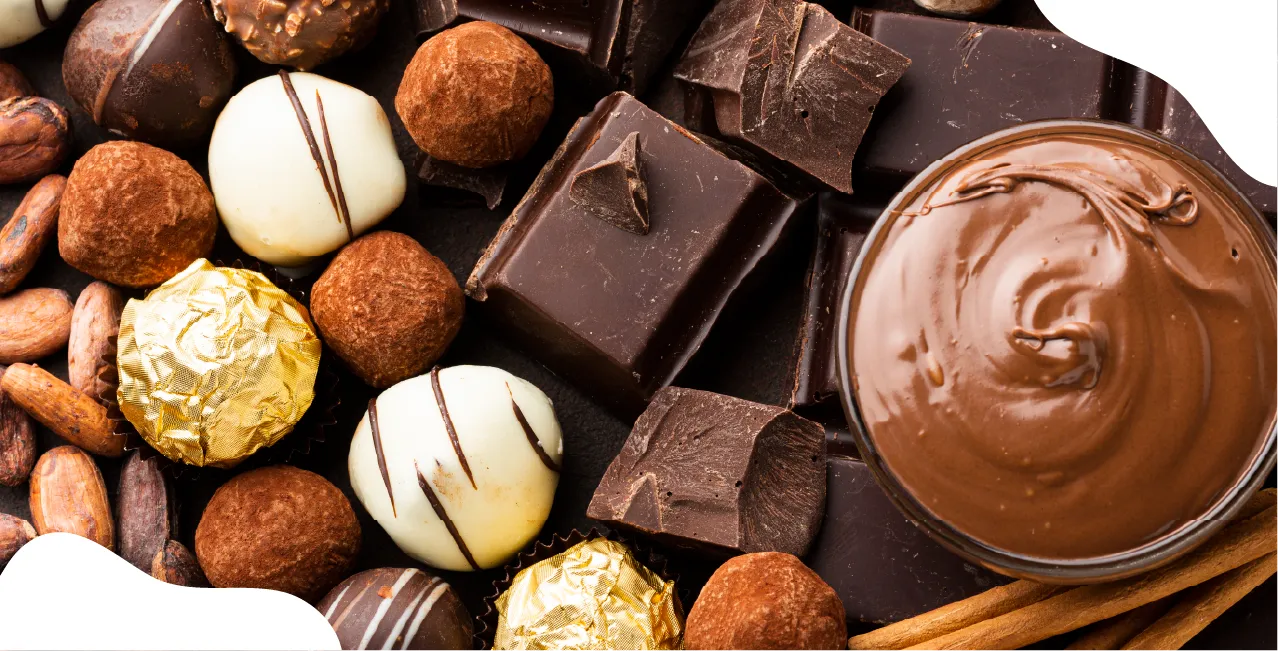
Author
LoansJagat Team
Read Time
7 Min
17 Jul 2025
GST on Chocolate – Tax Rate, HSN Code & Billing Guide
Arjun had a big date coming up. Wanting to impress, he decided to create a luxury chocolate hamper costing ₹1,000. He picked up a mix of dark truffles, milk chocolate with nuts, and creamy white pralines. At checkout, the bill shocked Arjun; it was ₹1,280.
"Wait, what?" he asked. "I thought it was ₹1,000."
The cashier smiled. "GST, sir. Some chocolates are taxed at 28 per cent."
That was the day Arjun discovered that India’s GST law treats chocolates differently and that one’s choice of treat can directly affect the cost.
So, what exactly is the GST on chocolate, and why does that creamy bar cost more than you thought?
GST Rate on Chocolate – Different Flavours, Different Taxes:
When it comes to chocolates under GST, it is not just about how sweet or bitter a chocolate bar is; it is about what is inside.
Take Riya again. After buying a plain dark chocolate bar the previous day, she thought she’d try something more indulgent. So she picked up a milk chocolate bar with roasted almonds from a premium brand, priced at ₹200.
At checkout, she noticed the bill was ₹256.
She asked, “Wasn’t it ₹200?”
The storekeeper explained:
GST 28% is applied on chocolates that have added ingredients like nuts, milk solids, or wafers.
Let’s break it down:
-
Product Price: ₹200
-
GST 28%: ₹200 × 28% = ₹56
- Final Bill: ₹200 + ₹56 = ₹256
Now imagine if Riya had picked up a plain dark chocolate bar instead:
-
Product Price: ₹200
-
GST 18%: ₹200 × 18% = ₹36
- Final Bill: ₹236
That’s a difference of ₹20, not because of price, but because of what's mixed in the chocolate.
Why Does This Happen?
Under GST, the more processed or value-added a product is, the higher the tax rate it attracts. Plain dark chocolate, with minimal ingredients, is taxed at 18%, while fancier chocolates with extra ingredients like milk, nuts, caramel, or wafers are taxed at 28%.
Here’s a Quick Table for Reference:
Example: Let’s say Rahul buys two chocolates:
A 100g dark chocolate bar for ₹150:
- GST 18% = ₹27
-
Total = ₹177
A 100g milk chocolate bar with hazelnuts for ₹150:
- GST 28% = ₹42
- Total = ₹192
Even though both chocolates cost the same on the label, Rahul ends up paying ₹15 more just for the nuts.
HSN Code for Chocolate – Understanding the Classification
Now, imagine Riya isn’t just a chocolate lover anymore; she’s turned her passion into a business. She runs a boutique bakery and regularly buys bulk chocolate slabs for baking, priced at around ₹5,000 per batch.
When placing an order from her supplier, she notices a small but important detail on the invoice: HSN Code: 1806.
Why does this matter?
Well, the HSN code (Harmonised System of Nomenclature) is what determines how much GST she pays and whether she can claim Input Tax Credit (ITC) on her purchases.
In this case, since Riya’s buying plain dark chocolate (used as an ingredient in cakes and desserts), it falls under HSN Code 1806, which covers chocolate and food items containing cocoa.
Here’s how the GST works out for her:
Invoice amount: ₹5,000
Applicable GST @18%: ₹5,000 × 18% = ₹900
Total paid: ₹5,900
Since her business is GST-registered, Riya can now claim the ₹900 as Input Tax Credit, reducing her overall tax burden.
HSN Code for Chocolate
Why Is the HSN Code Important?
For manufacturers, bakers, and even chocolatiers:
Using the right HSN code ensures you’re applying the correct GST rate.
It helps in avoiding penalties or mismatches during GST filings.
It also allows businesses to claim Input Tax Credit (ITC) properly on raw materials like chocolate slabs, wrappers, packaging, etc.
In short, even though HSN codes may seem like just numbers on an invoice, they play a crucial role in cost management and compliance for any business dealing with chocolates.
Types of Chocolate & Their GST Applicability – Let’s Compare
Riya, now preparing a festive chocolate hamper for her clients, picks three different chocolate bars, each priced at ₹500. But the cost she pays for each isn't the same. Why? Because different chocolates attract different GST rates.
Let’s see how the taxes add up:
So, although each chocolate starts at the same price, Riya ends up paying ₹50 more for the nutty and caramel ones just because of their GST slab. That’s nearly ₹100 extra for two fancier bars.
When creating chocolate gifts or buying in bulk, this price difference becomes quite noticeable, especially for retailers and wholesalers who need to manage margins.
Impact of GST on Chocolate Prices – What Changed After 2017?
Before GST came into play, buying chocolates was slightly more pocket-friendly. Riya remembers buying her favourite milk chocolate bar in 2016 for just ₹50, all taxes included. Back then, state VAT and other levies applied differently across regions.
However, in July 2017, when GST was implemented with standard tax slabs, the price of the same milk chocolate, especially those containing nuts or milk solids, increased to ₹64, as GST at 28 per cent applied.
Here’s how the difference adds up if Riya buys 10 bars today:
-
Before GST (2016): ₹50 × 10 = ₹500
-
After GST (2025): ₹64 × 10 = ₹640
- Total increase: ₹140
This shift did not just affect customers like Riya; manufacturers and sellers also had to rethink their pricing, sourcing, and packaging strategies to stay competitive while complying with the new taxation norms.
GST made the system more uniform and transparent, but it also made indulgent treats like chocolate slightly more expensive, especially when they are value-added or premium products.
How to Calculate GST on Chocolate?
Riya decides to buy a luxurious chocolate gift box for her best friend’s birthday. The box costs ₹2,000 and contains caramel-filled, nutty, and wafer-layered chocolates. Sounds delicious, right?
But here's where GST steps in — these types of "value-added" chocolates fall under the 28% GST slab.
Let’s do the math:
-
GST 28% = ₹2,000 × 28% = ₹560
- Total Bill = ₹2,000 + ₹560 = ₹2,560
Now, Riya wonders, what if she had opted for a simpler box filled only with plain dark chocolates, which attract 18 per cent GST?
-
GST 18% = ₹2,000 × 18% = ₹360
- Total Bill = ₹2,000 + ₹360 = ₹2,360
That’s a ₹200 difference — just because of caramel and nuts!
Riya’s friend, who runs a home baking business, gives her a useful tip:
“If you're buying chocolates for gifting or resale, separating items by type can help reduce the GST load, especially when the higher-taxed ones aren’t really necessary.”
That is the magic of understanding GST; it helps make wiser buying decisions, even with sweet indulgences.
Input Tax Credit (ITC) on Chocolate
Riya isn’t just a chocolate lover; she also runs a cosy little bakery in Pune where she bakes gooey brownies, frosted cupcakes, and luscious chocolate cakes. Naturally, she needs a lot of chocolate for her business.
Every month, Riya purchases:
-
₹10,000 worth of plain dark chocolate - 18% GST = ₹1,800
- ₹5,000 worth of milk chocolate with almonds - 28% GST = ₹1,400
Since both are used strictly for business purposes (not for gifting or personal use), she can claim a total Input Tax Credit (ITC) of:
₹1,800 + ₹1,400 = ₹3,200
But she can do this only because:
-
She is a registered GST taxpayer
-
Her supplier provides a valid GST invoice
-
The HSN code 1806 is mentioned
- The chocolates are used in her business operations
If Riya wasn’t registered under GST, this ₹3,200 benefit would go to waste, eating into her profits.
So yes, even for something as sweet as chocolate, the right GST compliance, billing, and documentation can make a real financial difference.
Conclusion
Understanding GST on chocolate helps you shop smarter and helps businesses set better prices. Whether it’s a basic chocolate or a fancy one, knowing the tax makes your bill clearer and helps you plan costs.
This knowledge also stops surprises when you pay. Businesses can manage their taxes better and offer fair prices. So next time you enjoy your favourite chocolate bar, remember you’re also experiencing how taxes work. It’s not just about taste, it's about knowing what you pay for.
FAQs
1. What is the GST rate for dark chocolate?
18%, provided it’s plain and doesn’t have added ingredients.
2. Is GST on chocolate the same for all types?
No. Plain chocolate = 18%, chocolate with fillings = 28%.
3. What’s the HSN code for chocolate bars and spreads?
HSN Code is 1806 for chocolate and cocoa preparations.
4. Why does milk chocolate have more GST?
Because it includes added ingredients like milk solids, flavourings, or nuts, which are considered luxury or processed items.
5. Can I claim ITC on chocolate purchases?
Yes, but only for business use, not for personal consumption.
Other Important GST Pages | ||||
About the Author

LoansJagat Team
‘Simplify Finance for Everyone.’ This is the common goal of our team, as we try to explain any topic with relatable examples. From personal to business finance, managing EMIs to becoming debt-free, we do extensive research on each and every parameter, so you don’t have to. Scroll up and have a look at what 15+ years of experience in the BFSI sector looks like.

Quick Apply Loan
Subscribe Now


